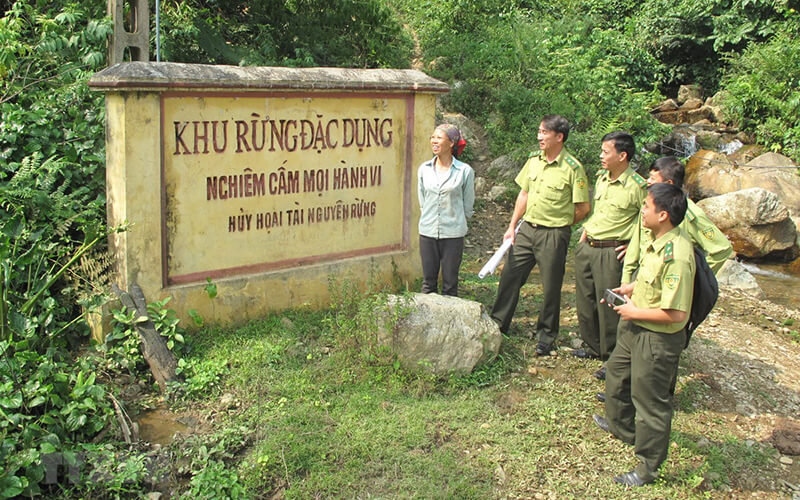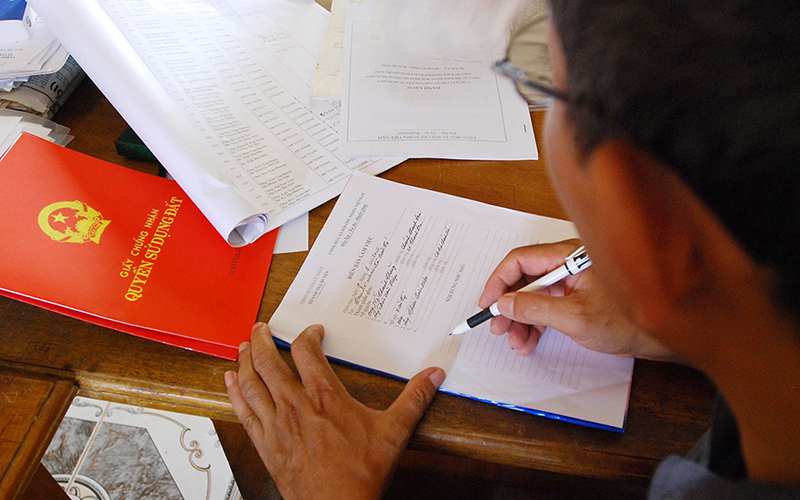The process of buying and selling land is considered quite important, but it also entails risks. Therefore, to minimize unwanted occurrences during land transactions, you must understand the legal regulations regarding the procedures.
If you are still unclear about this issue, let’s refer to our guide on the latest legal land buying and selling procedures for 2021 below.
1 Conditions for Land Use Rights Transfer
Conditions for the Transferor
According to Clause 1, Article 188 of the 2013 Land Law, a land user is allowed to transfer land use rights when meeting the following conditions:
- Possess a certificate (except for cases stipulated in Clause 3, Article 186 and cases of inheritance stipulated in Clause 1, Article 168 of the 2013 Land Law).
- The land is free from disputes.
- The land use rights are not subject to enforcement for the execution of judgments.
- The land is within the time limit of land use.
In some cases, in addition to the transferor meeting the conditions, the transferee must also not fall under the cases prohibited from receiving the transfer.
Conditional Transfer Cases
 Ecological Restoration Subdivision of Special-Use Forest
Ecological Restoration Subdivision of Special-Use Forest
Article 192 of the 2013 Land Law provides detailed regulations on three cases where households and individuals transfer land use rights with conditions, including:
- Households and individuals living interspersed in the strict protection and ecological restoration subdivisions of special-use forests, but who have not yet had the conditions to move out of these subdivisions, are only allowed to transfer land use rights for residential purposes and land for combined agricultural, forestry, and aquatic production to households and individuals living in the same subdivision.
- Households and individuals who have been allocated land for residential and agricultural production purposes in the protective forest area are only allowed to transfer land use rights for residential and agricultural production purposes to households and individuals living in the same protective forest area.
- Ethnic minority households and individuals using land allocated by the State under its support policies are allowed to transfer land use rights after 10 years from the date of the land allocation decision.
Cases Prohibited from Receiving the Transfer
 Rice Land
Rice Land
In accordance with Article 191 of the 2013 Land Law, the following cases are prohibited from receiving the transfer of, or donation of, land use rights:
- Organizations, households, individuals, community-based organizations, religious organizations, overseas Vietnamese, and foreign-invested enterprises are not allowed to receive the transfer of, or donation of, land use rights in cases where the law does not permit the transfer of land use rights.
- Economic organizations are not allowed to receive the transfer of land use rights for rice land, protective forests, and special-use forests from households and individuals, except for cases where the land use purpose is converted according to the approved land use planning and plan.
- Households and individuals who do not directly engage in agricultural production are not allowed to receive the transfer of, or donation of, land use rights for rice land.
- Households and individuals are not allowed to receive the transfer of, or donation of, land use rights for residential purposes and agricultural land in the protective forest area and the strict protection and ecological restoration subdivisions of special-use forests if they do not live in these protective forest and special-use forest areas.
2 Can Land Under Planning Be Transferred?
First of all, to determine whether a land plot is under planning, people can check through the following methods:
- View the land use planning directly at the People’s Committee of the district or communal level.
- View it on the website of the district-level People’s Committee.
- Ask for the opinions of the communal-level land administrative staff or local residents in the area where the land plot is located to obtain more information.
- Obtain information from the Land Registration Office.
Based on the provisions of Article 49 of the 2013 Land Law, amended and supplemented by the 2018 Law amending and supplementing a number of articles of 37 laws related to planning, in cases where the land use planning has been announced but there is no annual land use plan of the district-level People’s Committee, the land user is allowed to continue using the land and exercise the rights of the land user in accordance with the law.
 Land Under Planning
Land Under Planning
In cases where there is an annual land use plan of the district-level People’s Committee, the land user in the area (who must convert the land use purpose and recover the land in accordance with the plan) is allowed to continue exercising the rights of the land user but not allowed to build new houses, works, or plant long-term trees. If the land user has a need to renovate or repair existing houses or works, they must obtain permission from the competent state agency in accordance with the law.
According to the above regulations, if the land is under planning but has not been included in the annual land use plan of the district-level People’s Committee, or has been included in this plan, the land user in the area is still allowed to transfer land use rights in accordance with the provisions of Article 167 of the 2013 Land Law.
In summary, land under planning can still be transferred. To ensure that the transfer complies with legal regulations, it is necessary to meet several conditions stipulated in Clause 1, Article 188 of the 2013 Land Law:
- Possess a certificate, except for cases stipulated in Clause 3, Article 186 and cases of inheritance stipulated in Clause 1, Article 168 of this Law.
- The land is free from disputes.
- The land use rights are not subject to enforcement for the execution of judgments.
- The land is within the time limit of land use.
If the land under planning still falls under the cases allowed for transfer, the transfer procedure will be the same as that for the regular transfer of land use rights. First, both parties will go to a notary public office to create a land use rights transfer contract and have it notarized.
Then, they will declare financial obligations at the Land Registration Office. Next, they will declare the dossier for changing the name on the certificate. Finally, both parties will pay the full fees as prescribed and receive the Red Book. That’s it!
3 Land Buying and Selling Procedures
Step 1: Deposit (not mandatory)
 Deposit
Deposit
Based on Clause 1, Article 328 of the 2015 Civil Code, a deposit is an act by which one party transfers to the other party a sum of money or precious metals, precious stones, or other valuables within a certain period to guarantee the conclusion or performance of a contract.
Therefore, in the case of buying and selling land, the buyer will transfer a sum of money to the seller to guarantee the conclusion and performance of the land transfer contract.
Legal consequences of the deposit:
Case 1: If the contract is concluded and performed
The deposit will be refunded to the buyer or deducted from the payment amount.
Case 2: If the prospective buyer refuses to conclude and perform the contract
If the buyer backs out, the deposit will belong to the seller.
Case 3: If the seller refuses to conclude or perform the contract
If the seller backs out, they must refund the deposit and pay an amount equivalent to the value of the deposited asset (deposit penalty).
Step 2: Notarize the Land Transfer Contract
 Notarize the Land Transfer Contract
Notarize the Land Transfer Contract
After the deposit or no deposit agreement, the parties will proceed to notarize the contract at a Notary Public Office (of the State) or a Notary Public Office (private) within the province or city where the land is located as follows:
Step 1: Prepare the notarization dossier
According to Clause 1, Article 40 and Article 41 of the 2014 Notary Law, the parties need to prepare a set of documents, including the following papers:
Documents required from the seller:
- Land use right certificate.
- Personal papers: ID card/citizen identification card/passport (of the husband and wife).
- Household registration book.
- Marriage registration certificate or papers certifying the marital relationship.
- Power of attorney (in case of transferring land on behalf of someone else).
Documents required from the buyer:
- Personal papers: ID card/citizen identification card/passport with a valid period of use.
- Household registration book.
- Marriage registration certificate or papers certifying the marital relationship.
One of the two parties needs to prepare:
- Request for notarization, usually prepared by the buyer according to the form of the notary practice organization, but it can also be prepared by the parties upon agreement because, according to the regulations, the party requesting notarization must pay the notarization fee (unless otherwise agreed by the parties).
- In addition to the above papers, the parties can also prepare the contract in advance. However, usually, the contract will be prepared by the notary organization.
Step 2: Notarize the Land Transfer Contract at the Notary Organization
Step 3: Declare Financial Obligations
 Declare Financial Obligations
Declare Financial Obligations
The dossier for declaring tax on personal income, stamp duty, and registration fee includes:
- Tax declaration form No. 03/BĐS-TNCN.
- Original copy of Form No. 01 for stamp duty declaration.
- Copy of the Red Book, with the individual signing a commitment to take responsibility for the copy.
- Land transfer contract.
- Papers certifying eligibility for tax exemption or reduction (if any).
Time limit for submitting the declaration dossier:
- In cases where the land transfer contract does not stipulate that the buyer will pay the tax on behalf of the seller, the declaration dossier must be submitted no later than the 10th day (from the date the land transfer contract takes effect).
- In cases where the land transfer contract stipulates that the buyer will pay the tax on behalf of the seller, the declaration dossier must be submitted no later than when performing the procedures for registering the ownership or land use right.
- Submit the stamp duty declaration dossier at the same time as performing the procedures for registering land-related changes (changing the name on the Red Book).
Step 4: Submit the Dossier for Changing the Name on the Red Book
 Dossier for Changing the Name on the Red Book
Dossier for Changing the Name on the Red Book
The dossier includes:
- Application for land-related changes registration, Form No. 09/ĐK.
- Original copy of the issued certificate.
- Not
What is a Land Use Right Certificate (the “Red Book”) and a House Ownership Certificate (the “Pink Book”)? Everything You Need to Know About These Certificates in Vietnam.
What are the Red Book and the Pink Book? These are essential documents regarding land and property ownership in Vietnam. Understanding these documents is crucial for anyone looking to buy or sell real estate in the country. Join us as we delve into the world of the Red Book and the Pink Book and uncover everything you need to know about these vital records.



































